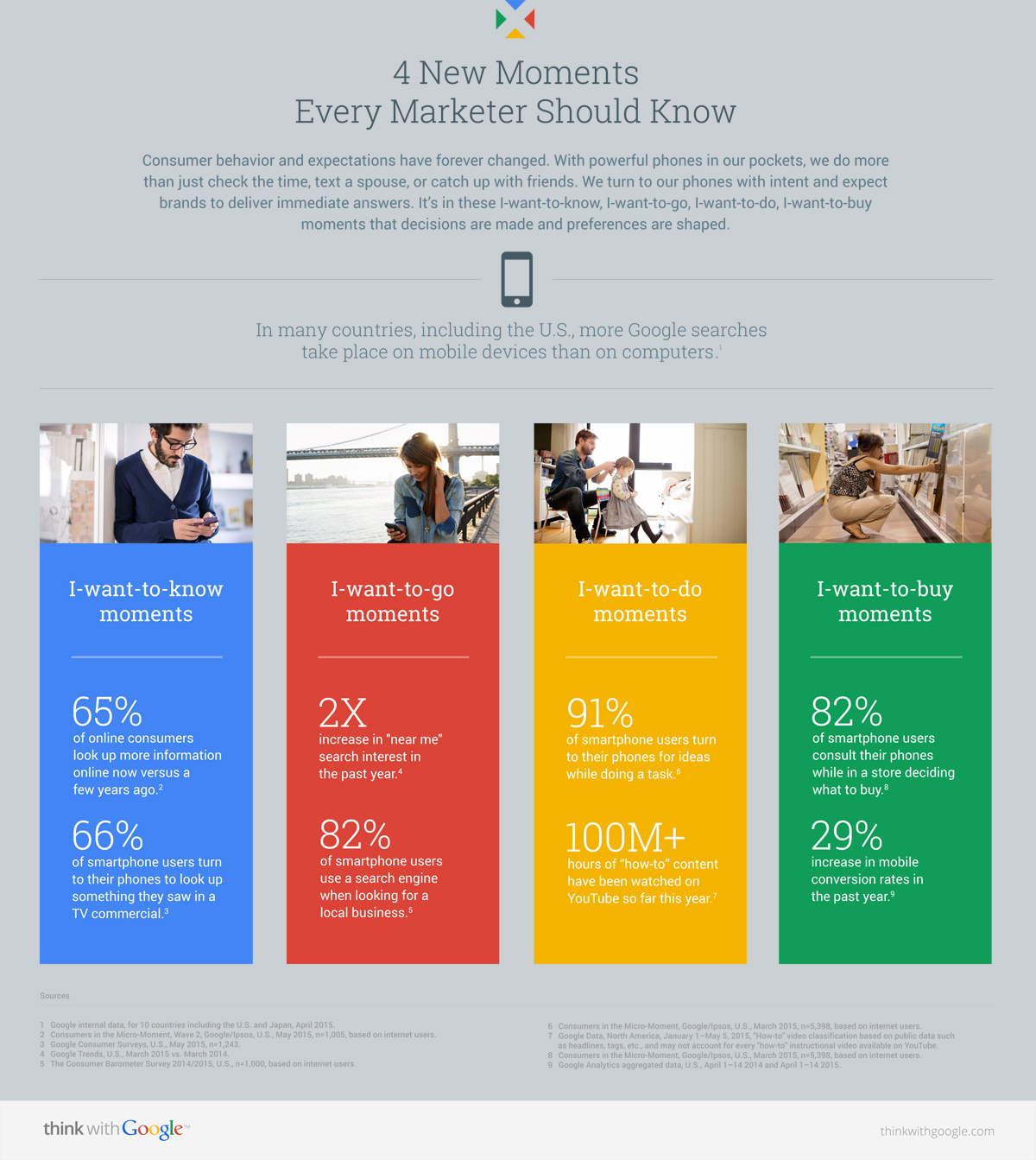Micro-Moments Turn Browsers Into Buyers One Device at a Time
For today’s connected consumers, I-want-to-buy micro-moments can happen any time on any device, and that goes for B2B buyers too. Even if you already provide an omni-channel experience, you could lose buyers if you haven’t designed each experience to convert.
Micro-Moments are Turning Browsers Into Buyers One Device at a Time
If you think that most of the purchases that follow mobile searches happen online, you’re wrong. Data pulled by the think-tank publishing at thinkwithgoogle.com are offering some valuable insights that can help omni-channel marketers better understand the buying journey and the role that each channel plays in the process. Case in point:
“What starts as a micro-moment often leads to engagement and even consummation within other channels; comScore’s Local Search Study, for example, found the majority of purchases following a mobile search happened not online, but in a physical store (73%) or on the phone (16%).” Lisa Gevelber, writing in Winning Omni-Channel Shoppers in Their Micro-Moments on thinkwithgoogle.com
I-want-to-know, I-want-to-go, I-want-to-do and I-want-to-buy moments can happen at any time; thanks to mobile devices, consumers can also fulfill these wants and needs when and where they occur. They’re called micro-moments.
Google first introduced us to these micro-moments (or at least gave them an official name), defining them as critical touchpoints within a customer’s journey which – when added together – determine how the journey ends (Micro-Moments: Your Guide to Winning the Shift to Mobile, thinkwithgoogle.com).

Micro-Moments in Omni-Channel Marketing
Consumer’s use of mobile devices is nothing short of astounding, especially as it pertains to buying journeys. Consider this:
- 91% of smartphone users turn to their phones for ideas while doing a task
- 82% of smartphone users consult their phones while in a store deciding what (and where) to buy
- 84% of smartphone and tablet users use their devices as a second screen while they watch television
What’s more, consumers have discovered the “near me” functionality provided by Google; the use of searches “near me” has increased 34x since 2011 and doubled since 2014. The vast majority of near me searches occur on mobile devices, leading to instant action:
- 50% of consumers conducting local searches on their smartphones visited a store that day
- 18% of those searches led to same-day purchases
- About half of restaurant searches occur within an hour of going (60% for millennials)
Omni Channel, Micro-Moments and Marketing Takeaways
1. Your content needs to be there when micro-moments occur.
There’s no substitute for publishing high-quality, audience-relevant, search-optimized content. And yes, that’s a lot of hyphenated phrases. But here’s the thing: When your customer has a question or a lead is doing research, do you want them to find reviews and recommendations on your site, or your competitors?
Make sure you’re in the mix. The 10 Skills Content Marketers Must Have can help you reverse engineer the type of online content that your site needs to have. Beginning with an understanding of your customer’s buying journey, relying on sound research in terms of keywords and what matters to your audience, and knowing how to use content in an omnichannel world, if your content isn’t there, your audience can’t find you!
2. Mobile device use is a critical touch point whether a purchase happens online or in store.
- 87% of consumers do research before entering a store (thinkwithgoogle.com)
- 73% of purchases following a mobile search occurred in a physical store (comScore via thinkwithgoogle.com)
When you add to the mix that more than half of all Google searches occurred on mobile devices for the first time ever this year, it’s easy to see why so many marketing experts espouse a “mobile first” marketing strategy. That said, it’s also important to remember that many shoppers use multiple devices and hit multiple customer touch points before deciding to buy from your business or after becoming a customer; e.g., it’s not a mobile-only marketing world.
3. Micro-moments support the local economy.
Mobile searches performed just before shopping or while shopping often lead to the discovery of new locally owned businesses as well as large chain stores. For consumers who value buying locally to support small business, this can be an invaluable tool in helping them discover small businesses, which in turn helps to support the local economy far more than dollars spent shopping at big chain stores. About 45 percent of every dollar of revenue spent at a locally-owned business – nearly half – stays in the local community, vs. just 14 percent of revenue spent at chain stores.
4. You don’t know what you don’t know.
If your marketing attribution research and tracking never takes you further than the customer touchpoint that preceded a customer visit, form submission or phone call, it’s a safe bet that you do not have a complete picture of the role that all customer touchpoints might be playing in buyer journeys. This is both an argument for improving your attribution model and also continues to make the case for omnichannel marketing. If you don’t know which customer touchpoints are influencing buyers, it’s doubly important that you don’t leave any of them up to chance!
5. Don’t fence them in.
While it might be tempting to try to categorize customers – or even herd them – into engaging with your brand into a single marketing channel or touchpoint that might be a big mistake. Case in point, Target’s most valuable customers are its omnichannel shoppers, who spend not just a little, but a lot more than other shoppers, on average 3x as much as single-channel shoppers.
Traditional marketing was all about trying to get shoppers in the front door. Omni-channel marketing is about ensuring your brand’s marketing channels ability to meet customers where they are, wherever they are, whenever they are ready to engage. Micro-moments represent those moments when consumers are ready to engage because they want to know something, learn something, do something, go somewhere, or acquire something. These are the moments that turn browsers into buyers, on any device, at any customer touch point.





Trackbacks & Pingbacks
[…] a positive experience across all of these channels may seem like a daunting task; nevertheless, for your business to grow, paying attention to the […]
Comments are closed.